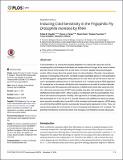Files in this item
Inducing cold-sensitivity in the frigophilic fly Drosophila montana by RNAi
Item metadata
| dc.contributor.author | Vigoder, Felipe M. | |
| dc.contributor.author | Parker, Darren James | |
| dc.contributor.author | Cook, Nicola | |
| dc.contributor.author | Tournière, Océane | |
| dc.contributor.author | Sneddon, Tanya | |
| dc.contributor.author | Ritchie, Michael Gordon | |
| dc.date.accessioned | 2016-11-11T09:30:14Z | |
| dc.date.available | 2016-11-11T09:30:14Z | |
| dc.date.issued | 2016-11-10 | |
| dc.identifier | 247455510 | |
| dc.identifier | 882caca0-0202-43e0-8be6-4dc501e59e12 | |
| dc.identifier | 84994796533 | |
| dc.identifier | 000387725000030 | |
| dc.identifier.citation | Vigoder , F M , Parker , D J , Cook , N , Tournière , O , Sneddon , T & Ritchie , M G 2016 , ' Inducing cold-sensitivity in the frigophilic fly Drosophila montana by RNAi ' , PLoS One , vol. 11 , no. 11 , e0165724 . https://doi.org/10.1371/journal.pone.0165724 | en |
| dc.identifier.issn | 1932-6203 | |
| dc.identifier.other | ORCID: /0000-0001-7913-8675/work/46761139 | |
| dc.identifier.other | ORCID: /0000-0003-4462-0116/work/60427612 | |
| dc.identifier.uri | https://hdl.handle.net/10023/9804 | |
| dc.description | The work was supported by CNPq (Fellowship to FMV) and a NERC Studentship to DJP. | en |
| dc.description.abstract | Cold acclimation is a critical physiological adaptation for coping with seasonal cold. By increasing their cold tolerance individuals can remain active for longer at the onset of winter and can recover more quickly from a cold shock. In insects, despite many physiological studies, little is known about the genetic basis of cold acclimation. Recently, transcriptomic analyses in Drosophila virilis and D.montana revealed candidate genes for cold acclimation by identifying genes upregulated during exposure to cold. Here, we test the role of myo-inositol-1-phosphate synthase (Inos), in cold tolerance in D. montana using an RNAi approach. D. montana has a circumpolar distribution and overwinters as an adult in northern latitudes with extreme cold. We assessed cold tolerance of dsRNA knock-down flies using two metrics: chill-coma recovery time (CCRT) and mortality rate after cold acclimation. Injection of dsRNAInos did not alter CCRT,either overall or in interaction with the cold treatment, however it did induced cold specific mortality, with high levels of mortality observed in injected flies acclimated at 5°C but not at 19°C. Overall, injection with dsRNAInos induced a temperature sensitive mortality rate of over 60% in this normally cold-tolerant species. qPCRanalysis confirmed that dsRNA injection successfully reduced gene expression of Inos. Thus, our results demonstrate the involvement of Inos in increasing cold tolerance in D. montana. The potential mechanisms involved by which Inos increases cold tolerance are also discussed. | |
| dc.format.extent | 9 | |
| dc.format.extent | 714870 | |
| dc.language.iso | eng | |
| dc.relation.ispartof | PLoS One | en |
| dc.subject | Drosophilia | en |
| dc.subject | Cold tolerance | en |
| dc.subject | RNAi | en |
| dc.subject | Thermal adaptation | en |
| dc.subject | QH301 Biology | en |
| dc.subject | QH426 Genetics | en |
| dc.subject.lcc | QH301 | en |
| dc.subject.lcc | QH426 | en |
| dc.title | Inducing cold-sensitivity in the frigophilic fly Drosophila montana by RNAi | en |
| dc.type | Journal article | en |
| dc.contributor.sponsor | NERC | en |
| dc.contributor.sponsor | NERC | en |
| dc.contributor.institution | University of St Andrews. Centre for Biological Diversity | en |
| dc.contributor.institution | University of St Andrews. School of Biology | en |
| dc.contributor.institution | University of St Andrews. Institute of Behavioural and Neural Sciences | en |
| dc.identifier.doi | 10.1371/journal.pone.0165724 | |
| dc.description.status | Peer reviewed | en |
| dc.identifier.grantnumber | NE/J020818/1 | en |
| dc.identifier.grantnumber | NE/P000592/1 | en |
This item appears in the following Collection(s)
Items in the St Andrews Research Repository are protected by copyright, with all rights reserved, unless otherwise indicated.

